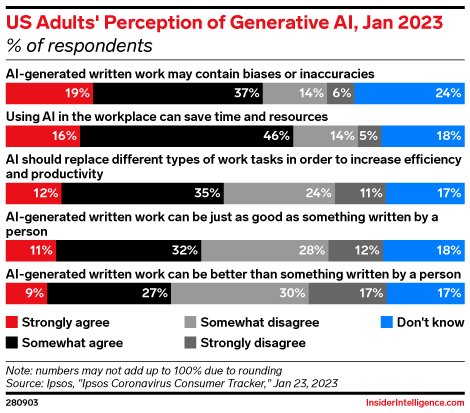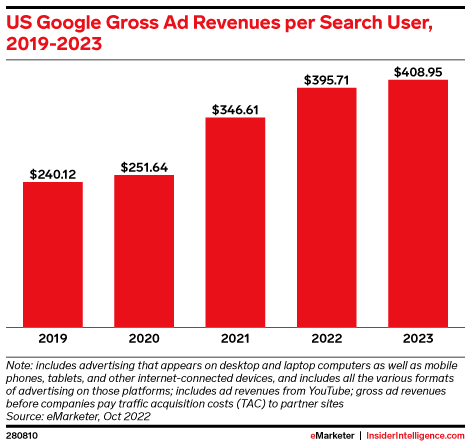Generative AI can already do much of the grunt work and low-skilled labor that powers modern media and advertising. But apprehension and mistrust—among consumers as well as advertisers and their agencies—will hold back widespread adoption of the technology.

 Key Takeaways
Key Takeaways
![]() Generative AI the potential to completely revolutionize how media and marketing works—and who it works for—provided the technology can clear several trust-related hurdles.
Generative AI the potential to completely revolutionize how media and marketing works—and who it works for—provided the technology can clear several trust-related hurdles.
![]() GenAI is changing the buyer’s life cycle, both customer facing and behind the scenes by boosting brand awareness, increasing engagement, accelerating conversion rates, improving retention rates, and turning satisfied customers into brand advocates.
GenAI is changing the buyer’s life cycle, both customer facing and behind the scenes by boosting brand awareness, increasing engagement, accelerating conversion rates, improving retention rates, and turning satisfied customers into brand advocates.
Generative AI is already playing a part in the media and marketing industries.
 The commercialization of the internet has placed immense strain on marketers, advertisers, publishers, and agencies trying to reach customers wherever they are.
The commercialization of the internet has placed immense strain on marketers, advertisers, publishers, and agencies trying to reach customers wherever they are.
The list of reachable channels never stops growing, and the measurability of (most) digital activity compels marketers to endlessly test, optimize, fuss, rinse, and repeat until something sticks.
 Many of digital advertising’s biggest spenders have looked for ways to combat this rapid road to burnout.
Many of digital advertising’s biggest spenders have looked for ways to combat this rapid road to burnout.
Generative AI has already insinuated itself into several low-risk functions, such as mockups and preliminary copywriting. And it may be capable of doing much higher-profile work, as recent marketing stunts, including Mint Mobile’s ChatGPT-written ad, suggest.
But questions over generative AI’s trustworthiness will prevent it from disrupting strategically important channels such as search ad spending. Google, Microsoft, and Amazon (and to a lesser extent, Meta), which will each play a pivotal part in deciding generative AI’s role in advertising, are likely to proceed with caution until they can be certain any business model for a generative AI-focused user experience is viable, as well as free of legal and regulatory risks.
Some GenAI applications are well established with marketers, and some are brand-new experiments. But already, ChatGPT is the most popular form of GenAI: 55% of Botco.ai survey respondents use the tool to bolster performance and efficiencies while delivering better, more seamless experiences that resonate with their customers.
Where will generative AI have the biggest impact?
Written and visual expression are the bedrock of the media and advertising industries. Consequently, generative AI has the potential to completely revolutionize how media and marketing works—and who it works for—provided the technology can clear several trust-related hurdles.
 Generative AI could largely cut out intermediate agencies.
Generative AI could largely cut out intermediate agencies.
As Google, Meta and other large self-serve ad-buying platforms continue to automate facets of their platforms, each could use generative AI technology to create businesses’ ads themselves, removing the need for agency input on many of the largest sources of ad-spending.
 It could up-end publishers’ relationships to search engines (again).
It could up-end publishers’ relationships to search engines (again).
After nearly two decades of fighting for compensation from the tech giants that use the content they publish, publishers face a fresh, existential threat from a technology that will soon be able to summarize reporting or synthesize press releases.
 It could reshape the economics of search advertising.
It could reshape the economics of search advertising.
Google has built an immensely profitable business in part by forcing brands to play defense and allowing multiple advertisers to compete for the attention of intent users. Generative AI’s definitive responses to queries could remove, or at least complicate, those markets.
 It could further erode public trust in media.
It could further erode public trust in media.
Automation and algorithms have significantly damaged the relationship between consumers and media companies. A flood of automatically generated, inaccurate content, even if it’s in lighter content categories, is likely to sow mistrust.

What are generative AI’s most promising media and advertising use cases?
Despite the flood of trade press, the US public is largely either unaware of generative AI or mistrustful of it: Just 30% of US adults have heard or read anything about ChatGPT, and only 10% regard its output as “very trustworthy,” according to Morning Consult. As such, its most promising uses are in the background for now.
 Generative AI can provide raw material or thought starters.
Generative AI can provide raw material or thought starters.
“The biggest factor for marketers isn’t tools. It’s time,” said Robert Barclay, vice president of product at Simon Data, a customer data platform. Generative AI cannot be trusted to produce content, but it can produce the scaffolding or launching point required to make it.
 Generative AI could help advertisers skip the A/B tests.
Generative AI could help advertisers skip the A/B tests.
AI platform Persado claims its technology delivers a better result than human-written copy 96% of the time.
 Generative AI can help new brands or cost-conscious advertisers increase their output.
Generative AI can help new brands or cost-conscious advertisers increase their output.
Startups such as Bestever, which creates text and visual assets for brands to use in digital ads, are already using generative AI to create ads at scale. While large corporate brands will likely have trouble incorporating AI-created content and assets into their advertising, younger nimbler brands could embrace the opportunity.
 Generative AI could keep the office informed.
Generative AI could keep the office informed.
In a fast-moving industry like media, it can be difficult to keep abreast of all the notable developments. An AI-written news digest published daily could help.
What are its limitations and pitfalls?
Generative AI effortlessly produces content that is clear, engaging, and grammatically correct but also frequently filled with factual inaccuracies and biases—and occasionally disturbing advice. Advertisers or publishers will publish or distribute ads or content created entirely by this technology at their peril.
 Sustainable models for summarizing news seem unlikely to materialize.
Sustainable models for summarizing news seem unlikely to materialize.
News Corp has begun discussing compensation models with OpenAI after it discovered evidence ChatGPT was using The Wall Street Journal content in its responses. The odds any level of licensing fee would satisfy News Corp, or its peer organizations, are low.
 One assistant to rule them all is unlikely.
One assistant to rule them all is unlikely.
Traditional search engines have lost credibility among most US adults—just 32% say they trust search results provided by algorithms, per Ipsos. Fewer people trust AI-produced results (27%), so don’t expect that people will take an assistant’s word for everything.
 Consumers don’t trust AI, so don’t give it customer-facing roles.
Consumers don’t trust AI, so don’t give it customer-facing roles.
Less than 10% of respondents to a Monmouth University poll conducted in January 2023 said AI would do more good than harm to the world. More than three-quarters said it would be bad if tools such as ChatGPT began writing news articles.
What can marketers and advertisers do now to prepare for the AI-driven future?
For all the negative sentiment and trepidation swirling around AI, consumers are resigned to the idea it will become part of our lives—52% think generative AI will stick around, according to Morning Consult. And with businesses and consumers both showing they have limited understanding of how generative AI can be used, there is plenty brands can do.
 Watch consumer adoption closely.
Watch consumer adoption closely.
Microsoft’s integration of ChatGPT into Bing gave the search engine a shot in the arm, as traffic inched up 7% year over year in January, according to Comscore. But that bump was temporary since interest in ChatGPT is building very unevenly.
 Think about how organizational assets and data could be used to train your own AI.
Think about how organizational assets and data could be used to train your own AI.
The marketing and messaging assets many mature organizations have could be used as a data set.
 Prepare for a learning curve.
Prepare for a learning curve.
While AI might seem like it just arrived, it has been here for years, and other brands report it regularly fails to deliver the impact many organizations expect—41% of AI projects fail to meet their stated goals, according to LXT, which provides AI training data to organizations.




 Key Takeaways
Key Takeaways
